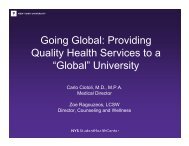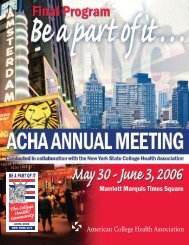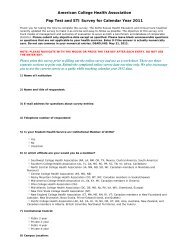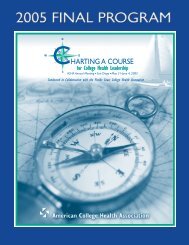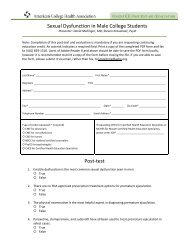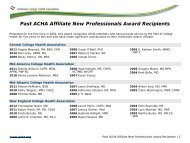Stimulant Misuse: Strategies to Manage a Growing Problem (.pdf)
Stimulant Misuse: Strategies to Manage a Growing Problem (.pdf)
Stimulant Misuse: Strategies to Manage a Growing Problem (.pdf)
- No tags were found...
You also want an ePaper? Increase the reach of your titles
YUMPU automatically turns print PDFs into web optimized ePapers that Google loves.
USE AND MISUSE OF STIMULANTS<br />
REVIEW ARTICLE<br />
<strong>Stimulant</strong> <strong>Misuse</strong>: <strong>Strategies</strong> <strong>to</strong> <strong>Manage</strong><br />
a <strong>Growing</strong> <strong>Problem</strong><br />
Donald E. Greydanus, MD<br />
Professor<br />
Pediatrics and Human Development<br />
Michigan State University College of Human Medicine<br />
Kalamazoo Center for Medical Studies<br />
Sindecuse Health Center<br />
Western Michigan University<br />
Kalamazoo, Michigan<br />
Individuals diagnosed with attention-deficit/hyperactivity<br />
disorder (ADHD) as children are increasingly likely <strong>to</strong> continue<br />
receiving treatment—usually in the form of prescription<br />
stimulants—in<strong>to</strong> their later teenage and young adult<br />
years. In addition, many people are also diagnosed with the<br />
condition during their high school and college years, which<br />
has led <strong>to</strong> a growing controversy over the extent of prescription<br />
stimulant use for ADHD. These concerns revolve around<br />
the notion that greater access <strong>to</strong> prescription-grade stimulants<br />
in the general population has led <strong>to</strong> a greater potential<br />
for their misuse. This article reviews information about the<br />
use and misuse of stimulants among high school and college<br />
students and offers recommendations <strong>to</strong> school health officials<br />
on recognizing the signs and symp<strong>to</strong>ms of stimulant<br />
misuse, education on the risks and benefits of stimulant use,<br />
and opportunities for prevention of misuse.<br />
Approximately 4% <strong>to</strong> 10% of high school and college students<br />
suffer from attention-deficit/hyperactivity disorder (ADHD). 1,2<br />
Prescription stimulants (eg, methylphenidate or amphetamines)<br />
are the most common pharmacologic treatments for<br />
ADHD. <strong>Stimulant</strong>s are classified as Schedule II drugs (ie, providing<br />
positive medicinal effects but also considerable abuse<br />
potential). The Controlled Substance Act mandates that<br />
Schedule II drugs may only be used if the drug is provided by a<br />
prescription written and signed by a licensed practitioner, and<br />
also dictates that a refill is only permitted if the patient returns<br />
<strong>to</strong> the practitioner for further assessment. 3,4<br />
Recent observations and academic research suggest that inappropriate<br />
use of stimulants in adolescents and young adults,<br />
both with and without clinically diagnosed ADHD, is a growing<br />
concern. <strong>Stimulant</strong> misuse of these medications is often<br />
predicated on students’ misconceptions or a simple lack of<br />
knowledge on the associated risks. Indeed, many consider stimulants—whether<br />
obtained by prescription or illicitly—a convenient<br />
option <strong>to</strong> improve performance or <strong>to</strong> induce euphoria.<br />
There are 4 main types of stimulants used for the treatment<br />
of ADHD—the most commonly used options are amphetamines<br />
(mixed amphetamine salts immediate- and extendedrelease)<br />
and methylphenidate (osmotically-controlled<br />
release oral delivery system, diffucaps methylphenidate,<br />
spheroidal oral drug absorption system methylphenidate<br />
long-acting). Dextroamphetamine is another of the 4 main<br />
types of stimulants.<br />
Amphetamines. Amphetamine products have been used as<br />
medication since the early 1880s, and the abuse potential for<br />
these products has been observed and studied for nearly 100<br />
years. 5,6 Amphetamine misuse is considered <strong>to</strong> be principally<br />
related <strong>to</strong> the drug’s euphoria-inducing effects. 6 Users’ desire <strong>to</strong><br />
achieve euphoric effects frequently involves administration of<br />
high doses, which increases the risk for compulsive abuse. 7<br />
Chronic amphetamine abuse has been shown <strong>to</strong> result in malnutrition,<br />
paranoid schizophrenia-like mental illness, sleep<br />
deprivation, cerebrovascular accidents, and death. 6-9 Specific<br />
amphetamine disorders (eg, amphetamine dependence and<br />
amphetamine abuse) and amphetamine-induced disorders<br />
(eg, amphetamine in<strong>to</strong>xication, amphetamine withdrawal,<br />
amphetamine in<strong>to</strong>xication delirium) are described in the<br />
American Psychiatric Association’s (APA) Diagnostic and<br />
Statistical Manual of Mental Disorders, Fourth Edition, Text<br />
Revision (DSM-IV-TR) classification. 6,8-11<br />
ACHA PROFESSIONAL DEVELOPMENT PROGRAM 17
Table 1. DSM-IV-TR Criteria for Substance Dependence 11<br />
Meeting 3 or more of the following criteria classifies an individual as substance dependent<br />
• Tolerance<br />
• Withdrawal<br />
• More drug consumption than intended (in overt amounts or time of abuse)<br />
• Consistent longing or craving <strong>to</strong> control the abuse or failed attempts for control<br />
• Persistent drug use despite knowledge of its negative consequences<br />
• Spending excessive time in finding the drug or recovering from its use<br />
• Reduction in positive living (ie, less time in class or at work)<br />
DSM-IV-TR = Diagnostic and Statistical Manual of Mental Disorders, Fourth Edition, Text Revision.<br />
Methamphetamine, now infrequently prescribed for ADHD,<br />
has the greatest addiction potential of the stimulants and is<br />
currently difficult <strong>to</strong> obtain by prescription in many places in<br />
the United States. Methamphetamine and 3,4-methylenedioxymethamphetamine<br />
(MDMA) abuse has become a serious<br />
problem in many parts of the world, including the<br />
United States. 6-9 Street names for amphetamine include<br />
speed, meth, and chalk; names for methamphetamine<br />
include crank, fire, glass, meth, and chalk. 9 Street names for<br />
MDMA include ecstasy, dex, essence, diamonds, lover’s<br />
speed, Adam, X, bean, and others. 9<br />
Methylphenidate. The US Drug Enforcement Administration<br />
(DEA) has stated that methylphenidate confers a “high potential<br />
for abuse and produces the same effects as cocaine or the<br />
amphetamines,” and cases of oral, intranasal, and intravenous<br />
abuse of the drug are well documented. 3,12,13 Although misuse<br />
of methylphenidate is considered <strong>to</strong> be less common than<br />
that of amphetamines, methylphenidate misuse may be<br />
underreported. 13<br />
The notion of <strong>to</strong>lerance <strong>to</strong> methylphenidate remains controversial,<br />
and is usually described in those who have been taking<br />
the drug at high doses over a period of several months or years. 1<br />
There are no well-controlled studies examining methylphenidate<br />
<strong>to</strong>lerance; anecdotally, however, clinicians and<br />
patients describe situations where decreased efficacy of<br />
methylphenidate, in addition <strong>to</strong> psychological dependence,<br />
appears <strong>to</strong> occur. 14 Street names for methylphenidate include<br />
vitamin R, the smart drug, R ball, the cramming drug, and<br />
poor man’s cocaine. 9,15 Depression may develop in students taking<br />
amphetamines or methylphenidate, and those taking either<br />
of these medications should be moni<strong>to</strong>red for mood changes. 16<br />
The potential for misuse has made the prescribing of stimulant<br />
medications for the management of ADHD symp<strong>to</strong>ms in high<br />
school and college students an area of some controversy.<br />
Awareness of this potential risk has encouraged clinicians <strong>to</strong><br />
evaluate students presenting with ADHD symp<strong>to</strong>ms with a<br />
more critical eye so as <strong>to</strong> ensure appropriate ADHD diagnoses.<br />
In order <strong>to</strong> provide guidance <strong>to</strong> school health officials—who<br />
are responsible for addressing the needs of students with<br />
ADHD while discouraging misuse of stimulant medications—<br />
the remainder of this article will review information about the<br />
use and misuse of stimulants, offering recommendations <strong>to</strong><br />
school health officials on improved recognition of signs and<br />
symp<strong>to</strong>ms of stimulant misuse, and addressing student education<br />
on the risks and benefits of stimulant use, and opportunities<br />
for misuse prevention.<br />
Defining Substance <strong>Misuse</strong>, Abuse, and<br />
Dependence<br />
Initial misuse of a stimulant medication—taking a stimulant<br />
not prescribed by a physician or in a manner not in accordance<br />
with physician guidance—is frequently the prelude <strong>to</strong><br />
chronic abuse (ie, use of nonprescribed doses nearly every<br />
day) or <strong>to</strong> drug dependence. The APA’s DSM-IV-TR views<br />
substance abuse as a mental disorder involving the use of a<br />
substance <strong>to</strong> a point that induces considerable dysfunction in<br />
the life of the abuser. 11 In the life of a student, medication<br />
abuse may impair his or her ability <strong>to</strong> achieve maximal success<br />
in school and <strong>to</strong> maintain social relationships. Abuse may also<br />
continue unabated even as abuse-related issues worsen. Such<br />
issues may include falling grades or overt academic failure,<br />
increased violence, legal troubles, overdose, and other compounding<br />
complications.<br />
Dependence may be diagnosed if the abuser qualifies for at<br />
least 3 of 7 DSM-IV-TR criteria for substance dependence<br />
(Table 1). 11 As the abuser builds a <strong>to</strong>lerance <strong>to</strong> a substance, the<br />
usual drug dosage provides less of the desired effect and<br />
increased amounts of the chemical may be necessary <strong>to</strong> achieve<br />
the same effect, often compounding the negative physical<br />
effects of the drug and increasing the potential for overdose.<br />
Prevalence of <strong>Stimulant</strong> <strong>Misuse</strong><br />
Nonmedical use of prescription medications represents the<br />
second most common form of illicit drug use in the college<br />
population, second only <strong>to</strong> marijuana use and abuse. 17<br />
According <strong>to</strong> the University of Michigan’s Moni<strong>to</strong>ring the<br />
Future study, college students report a 5.7% rate of nonprescription<br />
methylphenidate use in contrast <strong>to</strong> 2.5% in noncol-<br />
18<br />
ACHA PROFESSIONAL DEVELOPMENT PROGRAM
USE AND MISUSE OF STIMULANTS<br />
Table 2. Reasons/Rationale Why Individuals <strong>Misuse</strong> Prescription <strong>Stimulant</strong>s<br />
• Achieve a euphoric state<br />
• Increase mental alertness<br />
• Increase energy level<br />
• Ease of obtaining these medications from peers or clinicians<br />
• Reduce the pressures of academic life<br />
• Seen as a part of a plan <strong>to</strong> improve poor grades<br />
• Unsolicited “gift” from other students (eg, for sex or friendship)<br />
• Belief that it is a safe practice<br />
• Selling these medications <strong>to</strong> make money<br />
• Consistent with a lifestyle of polypharmacy (illict and nonillicit)<br />
lege peers. 17 A 2001 study of 10,904 college students using selfreports<br />
identified a 6.9% lifetime prevalence of nonmedical<br />
prescription stimulant misuse, including a past-year prevalence<br />
of 4.1% and a past-month prevalence of 2.1%. 18 A recent study<br />
by Teter et al of 9161 undergraduates reported an 8.1% lifetime<br />
prescription stimulant abuse rate among college students,<br />
including 5.4% over the past year. 19 A smaller study found that<br />
out of 179 college males and 202 college females surveyed, 17%<br />
of males and 11% of females had engaged in illicit prescription<br />
stimulant misuse. 20 According <strong>to</strong> a 2002 survey of a single US<br />
college, 35.5% of undergraduates reported using stimulants<br />
without a prescription, with greater frequency occurring in<br />
males compared with females. 21<br />
Obtaining <strong>Stimulant</strong>s Through Illicit Means<br />
Amphetamine and methylphenidate products are acquired in a<br />
number of ways, such as from classmates, friends, clinicians, or<br />
through the Internet. School health officials should be aware<br />
that students misusing stimulant medications may employ various<br />
means <strong>to</strong> gain access <strong>to</strong> these medications, such as stealing<br />
pills from a teacher’s desk (when a teacher is chosen <strong>to</strong> dispense<br />
medication <strong>to</strong> students), making arrangements with or exerting<br />
pressure on a classmate who has a legitimately prescribed<br />
medication, or presenting symp<strong>to</strong>ms of ADHD at the college<br />
health center in an attempt <strong>to</strong> be prescribed a stimulant. 20,22 The<br />
DEA reported nearly 700,000 methylphenidate doses s<strong>to</strong>len in<br />
the United States in 1996 and 1997. 15<br />
The diversion of stimulants is very common and can begin in<br />
childhood, adolescence, or young adulthood. One survey<br />
reported that 23.3% of middle and high school students taking<br />
prescribed stimulants had been solicited <strong>to</strong> divert their medication<br />
<strong>to</strong> others at a rate that increased from middle school <strong>to</strong><br />
high school. 23 A review of 161 elementary and high school students<br />
prescribed the stimulant methylphenidate revealed that<br />
16% had been asked <strong>to</strong> give or sell their medication <strong>to</strong> others. 24<br />
A self-reported anonymous questionnaire administered <strong>to</strong> a<br />
random sample of Canadian students in grades 7, 9, 10, and 12<br />
found that of the 5.3% of students who had used a legitimately<br />
prescribed stimulant over the previous 12 months, 14.7%<br />
reported having given their medications <strong>to</strong> others, 7.3% had<br />
sold their medications <strong>to</strong> others, and 4.3% had their medications<br />
s<strong>to</strong>len. 25 Data have shown that the diversion continues<br />
among college students. 5,18 A recent survey of 334 college students<br />
who were prescribed stimulants for ADHD revealed that<br />
nearly 29% had sold or given their medication <strong>to</strong> others. 10<br />
Reasons for <strong>Misuse</strong><br />
The motives for misuse and abuse of stimulants are numerous<br />
(Table 2). Studies have shown that students with and without<br />
ADHD misuse these medications <strong>to</strong> achieve euphoria. 10,20<br />
According <strong>to</strong> a survey of 334 ADHD-diagnosed college students<br />
taking prescription stimulants, 25% misused their own<br />
prescription medications <strong>to</strong> get high. 10 Students may also use<br />
stimulants <strong>to</strong> help cope with stressful fac<strong>to</strong>rs related <strong>to</strong> their<br />
educational environment. Pressures such as a persistent desire<br />
<strong>to</strong> succeed academically, erratic and poor sleep habits due <strong>to</strong><br />
large workloads, and the persistence of underlying social and<br />
financial demands may place students at an increased risk for<br />
misuse of various drugs, including stimulants. 19,20,26 Students<br />
often assume these drugs are safe <strong>to</strong> use for improving their<br />
energy levels, increasing their capacity for concentration,<br />
enhancing school performance, or for recreational use, while<br />
lowering their desire for sleep. 26 <strong>Stimulant</strong>s are especially popular<br />
at the end of a school term when students will often use the<br />
drugs <strong>to</strong> stay awake through the night <strong>to</strong> study for exams or<br />
complete academic projects.<br />
Any type of student may misuse stimulants, but there may be<br />
an increased risk among students with low grade-point averages<br />
(or an average that falls below a student’s personal standards)<br />
or those at very competitive schools. 18 Athletes may see<br />
stimulants as a way <strong>to</strong> help maintain physical fitness for their<br />
competitive sport or <strong>to</strong> improve their concentration. 27 Men<br />
appear <strong>to</strong> be more likely than women <strong>to</strong> misuse these drugs,<br />
but both sexes show similar motives for drug misuse. 18,19<br />
Relationship of <strong>Stimulant</strong> Use <strong>to</strong> Substance <strong>Misuse</strong><br />
A frequent concern regarding the use of stimulant medications<br />
is that their mechanisms of action, which provoke<br />
ACHA PROFESSIONAL DEVELOPMENT PROGRAM 19
changes in dopamine regulation in the central nervous system,<br />
may increase the risk for overt, illicit drug abuse.<br />
However, research points <strong>to</strong> the conclusion that people of<br />
any age receiving a medication for ADHD have no greater<br />
risk for illicit substance abuse compared <strong>to</strong> the general population.<br />
28-30 A meta-analysis of research studies concludes<br />
that there is a 50% reduction in later-life use of illicit drugs<br />
by those who have been prescribed stimulants in comparison<br />
<strong>to</strong> peers without ADHD. 31 One study observed that adolescents<br />
with ADHD who went untreated had a 3 <strong>to</strong> 4 times<br />
greater rate of illicit substance abuse patterns than those adolescents<br />
whose ADHD was treated with stimulants. 32<br />
A 13-year follow-up study of 147 individuals with ADHD<br />
confirmed data from 11 previous studies observing that illicit<br />
drug use in adulthood is not associated with childhood<br />
stimulant treatment of ADHD. 33 A subsequent study examining<br />
adults who were prescribed stimulants as children also<br />
noted no increase in substance use or abuse patterns at a<br />
mean follow-up age of 26 years. 34 Some research suggests a<br />
protective effect in which those who use prescription stimulants<br />
<strong>to</strong> manage their ADHD are less prone <strong>to</strong> using alcohol,<br />
cigarettes, marijuana, hallucinogens, or other drugs. 10,30 Thus,<br />
it may be concluded that while stimulant abuse warrants<br />
caution in prescribing <strong>to</strong> avoid inappropriate use of these<br />
medications, withholding stimulants from legitimate ADHD<br />
patients may confer an increased risk of future drug abuse.<br />
<strong>Stimulant</strong> <strong>Misuse</strong> Prevention: School-Based<br />
Modifications and Education<br />
Drug misuse on high school and college campuses in the<br />
United States has been a challenging issue for decades. 6,9,35<br />
While officials should be encouraged <strong>to</strong> improve their<br />
knowledge and resources for managing students who misuse<br />
these medications, treatment of overt stimulant addiction is<br />
difficult and prevention remains the most effective<br />
approach. 8 Table 3 outlines basic steps that can be taken by<br />
school officials <strong>to</strong> decrease the incidence of stimulant misuse<br />
on campus.<br />
Education Highlights on the Benefits of <strong>Stimulant</strong> Use, Risks<br />
of <strong>Misuse</strong>. The medical literature provides abundant data <strong>to</strong><br />
support the potentially positive effects of prescription stimulants<br />
for the majority of children, adolescents, and adults<br />
with ADHD. At the same time, many studies have revealed<br />
the numerous adverse effects associated with these medications<br />
when they are used inappropriately. With the aim of<br />
preventing drug misuse, it is advisable that all students be<br />
educated on the medical, psychological, and legal consequences<br />
of illicit drug use and abuse. The misconceptions of<br />
many students regarding the safety and benefits of stimulants<br />
can be effectively countered with education about the<br />
potential adverse effects of these drugs, including drug<br />
dependence, abuse, <strong>to</strong>lerance, withdrawal, and overdose.<br />
Adverse effects associated with amphetamines and methylphenidate<br />
are listed in Table 4. It is important <strong>to</strong> note, however,<br />
that for students with an accurate ADHD diagnosis who<br />
are receiving physician-prescribed stimulant therapy, many<br />
of the listed adverse effects will likely be transient and may be<br />
mitigated by initiating therapy with a low dose and slowly<br />
titrating upward. 1,16,36<br />
Since there are no long-term studies (ie, longer than 24<br />
months) on the use of stimulants for the management of<br />
ADHD, precise long-term effects—either adverse or positive—remain<br />
unknown. 37 Nevertheless, it is clearly unders<strong>to</strong>od<br />
that addiction may result from abusing stimulants <strong>to</strong><br />
achieve euphoria, especially if combined with alcohol. 15 An<br />
overdose of stimulants can result in <strong>to</strong>xicity, especially when<br />
part of a polydrug abuse pattern. When combined with alcohol,<br />
methylphenidate produces the metabolite ethylphenidate,<br />
which can induce <strong>to</strong>xic effects while simultaneously<br />
encouraging more drug ingestion due <strong>to</strong> the drug<br />
abuser’s sensation of less drunkenness and an elevation in<br />
euphoria. 12,38 Large doses of stimulants can lead <strong>to</strong> psychosis,<br />
seizures, and cardiovascular accidents, although sudden<br />
death is rarely reported in individuals taking stimulants. 39 If<br />
the drug is snorted, it can cause nasal cartilage damage and<br />
nosebleeds. Injection of stimulants is associated with<br />
increased risk of overdose, infection (including HIV, hepatitis<br />
B and C, abscesses, septicemia, and endocarditis), pulmonary<br />
embolism, retinal damage, and skin tracts. 9<br />
The ongoing availability and publicization of drug and alcohol<br />
abuse prevention programs may help offset the idea that drugs<br />
are a necessary and legitimate part of successful adulthood.<br />
Such programs should be aimed at teaching students <strong>to</strong> live<br />
successfully without resorting <strong>to</strong> drug use. Student athletes, in<br />
particular, should be apprised of the very serious consequences<br />
that can emerge when stimulants are used <strong>to</strong> improve<br />
Table 3. Steps for Improving <strong>Manage</strong>ment of <strong>Stimulant</strong> <strong>Misuse</strong> on the School Campus<br />
• Recognize the existence of this problem; survey one’s campus environment<br />
• Cooperation of university officials, health clinicians, college pharmacies, and local law enforcement officials<br />
• Limit availability and access <strong>to</strong> prescription stimulants<br />
• Educate high school and college students regarding the dangers of stimulant abuse<br />
• Recognize signs of stimulant misuse and abuse and provide management options<br />
20<br />
ACHA PROFESSIONAL DEVELOPMENT PROGRAM
USE AND MISUSE OF STIMULANTS<br />
sports performance. 27 Alcohol-free and other drug-free social,<br />
recreational, and extracurricular options and public service<br />
should be made available, providing students with opportunities<br />
<strong>to</strong> develop feelings of accomplishment and happiness<br />
within the community while free from the use of drugs. 15<br />
The Role of the Campus Health Center Clinician. The health<br />
center can serve as the hub of a drug abuse prevention effort<br />
<strong>to</strong> recognize, prevent, and manage prescription stimulant<br />
misuse and abuse among students. 35 College health center clinicians<br />
who prescribe stimulants (even if only refilling the<br />
prescription of another clinician) should be knowledgeable<br />
about ADHD and its treatments, should be able <strong>to</strong> recognize<br />
stimulant misuse as a serious problem, and should not be<br />
guided by preconceptions that stimulant misuse, abuse, and<br />
diversion are inevitable. Both clinicians and pharmacists<br />
need <strong>to</strong> be appropriately licensed <strong>to</strong> work with these drugs<br />
and observe DEA and local state laws for dispensing<br />
Schedule II drugs.<br />
High school health officials can help prevent diversion and<br />
misuse by forbidding students <strong>to</strong> be in possession of ADHD<br />
medication on school property, and <strong>to</strong> require a parent,<br />
guardian, or other appropriate adult <strong>to</strong> be responsible for the<br />
delivery and removal of medications from the school health<br />
center. Medication should be administered <strong>to</strong> the student<br />
through the school nurse, with the name, prescribed dosage,<br />
and dosing schedule clearly labeled on the container. The DEA<br />
Table 4. Potential Adverse Effects of <strong>Stimulant</strong>s 1<br />
Abdominal pain<br />
Anorexia<br />
Constipation<br />
Depression (not common)<br />
Dizziness<br />
Dry mouth<br />
Headache<br />
Height reduction in growing individuals (transient, secondary <strong>to</strong> anorexia)<br />
Insomnia<br />
Jitteriness<br />
Moodiness (irritability)<br />
Nausea<br />
Palpitations<br />
Psychosis (rare)<br />
Rebound<br />
Stimulation of vital signs (ie, mild increase in heart rate and blood pressure)<br />
Sudden death (very rare)<br />
Tolerance<br />
Unmasking of underlying tics or Tourette syndrome<br />
Weight loss<br />
Withdrawal<br />
recommends that school nurses keep a detailed log <strong>to</strong> moni<strong>to</strong>r<br />
the treatment his<strong>to</strong>ry and schedule of each student. 22 In addition,<br />
healthcare providers wishing <strong>to</strong> access additional<br />
resources on stimulant abuse may benefit from visiting the<br />
National Institute on Drug Abuse website at www.nida.gov/<br />
NIDAHome.html.<br />
<strong>Stimulant</strong> Prescribing Pro<strong>to</strong>cols. It is important that clinicians<br />
follow strict and appropriate pro<strong>to</strong>cols when prescribing stimulant<br />
medications <strong>to</strong> students. College health centers may<br />
develop their own policies for stimulant prescriptions, including<br />
limiting the amount prescribed and requiring appropriate<br />
medical documents for an ADHD diagnosis, although state<br />
laws regarding the number of dosage units per prescription<br />
should be observed.<br />
National prescribing standards dictate that a thorough neuropsychiatric<br />
evaluation be administered <strong>to</strong> any person<br />
requesting stimulants for attention-deficit problems. 1,5,40 It is<br />
advisable that school policies require students requesting<br />
refills of their stimulant prescriptions <strong>to</strong> supply evidence<br />
from the prescribing clinician that a neuropsychiatric evaluation<br />
has been performed supporting a diagnosis of ADHD.<br />
The student should also supply documentation from the prescribing<br />
physician confirming that appropriate moni<strong>to</strong>ring,<br />
via recognized rating scales—such as the Conners’ Adult<br />
ADHD Rating Scales (CAARS) 24 —has verified the effectiveness<br />
of the prescribed stimulant. If supportive documents<br />
are not available, the student should be carefully<br />
evaluated and screened by the school<br />
health center.<br />
It is important that students with prescription<br />
stimulants understand that they are the main<br />
source of diversion <strong>to</strong> other students, and<br />
should receive education in the prevention of<br />
stimulant diversion. Additionally, students<br />
should be advised <strong>to</strong> not exceed the manufacturer’s<br />
dose limits for prescription stimulants.<br />
Students with past or active drug abuse patterns<br />
should not be prescribed stimulants, as<br />
they are more likely <strong>to</strong> divert their prescription<br />
stimulants. 41 It is also important that athletes be<br />
warned that methylphenidate is banned by the<br />
National Collegiate Athletic Association<br />
(unless “medically warranted”), the US<br />
Olympic Committee, and the International<br />
Olympic Committee. 15,27<br />
The current epidemic of stimulant misuse in<br />
the United States has led some drug abuse<br />
experts <strong>to</strong> recommend that prescribing for<br />
ADHD begin with longer-acting stimulant<br />
formulations or those that cannot be easily<br />
ACHA PROFESSIONAL DEVELOPMENT PROGRAM 21
altered. 42 Longer-acting formulations may obviate the need for<br />
students with ADHD <strong>to</strong> bring their medications <strong>to</strong> school.<br />
One long-acting methylphenidate product, osmotically-controlled<br />
release oral delivery system methylphenidate, has the<br />
added advantage of being formulated such that it is difficult <strong>to</strong><br />
tamper with or alter the medication for nasal or intravenous<br />
abuse. 9,28,41<br />
Recognizing the Student Who <strong>Misuse</strong>s<br />
<strong>Stimulant</strong>s<br />
Health centers should aim <strong>to</strong> balance the provision of services<br />
for students possessing an ADHD diagnosis with the ability<br />
<strong>to</strong> recognize students who are misusing stimulants. 18<br />
Students illicitly using stimulants may present with a variety<br />
of signs and symp<strong>to</strong>ms (Table 5).<br />
Clinicians should be aware that individuals<br />
who insist that only a large<br />
dose is effective may be diverting the<br />
drug for money or personal abuse.<br />
Unexplained clinical features that do<br />
not fit with previous health records<br />
should prompt suspicion for drug misuse<br />
activity as well. Demanding times<br />
within the academic year, such as during<br />
finals, may lead <strong>to</strong> increased<br />
demand for stimulants. More students<br />
than usual may visit health services<br />
presenting unexplained anxiety, irritability,<br />
excited speech, tachycardia,<br />
hypertension, and confusion. Students<br />
with various unexplained negative<br />
behaviors, such as extreme irritability,<br />
depression, or violence, may be involved with illicit substance<br />
abuse, and prescribing stimulants should be avoided<br />
as these students are at increased risk for the development of<br />
stimulant misuse, abuse, and dependence. 18,42<br />
Summary<br />
Although stimulants have shown safety and efficacy in managing<br />
the symp<strong>to</strong>ms of ADHD when taken in accordance with a<br />
clinician’s guidance, there exists a significant potential for misuse.<br />
School officials, health centers, and students all play an<br />
important role in the prevention of stimulant misuse. As a<br />
result, education on the proper use of stimulants and on the<br />
signs and symp<strong>to</strong>ms of misuse and the health risks associated<br />
with misuse is an imperative. ■<br />
Table 5. Signs and Symp<strong>to</strong>ms of <strong>Stimulant</strong> Abuse<br />
• Anxiety and excited speech (may look like an acute panic attack)<br />
• Anorexia (can be severe)<br />
• Confusion<br />
• Depression<br />
• Increased pulse rate (tachycardia) and blood pressure (even overt hypertension)<br />
• Increased wakefulness and physical activity<br />
• Irritability<br />
• Infections from intravenous drug use (endocarditis, hepatitis, HIV, others)<br />
• Memory loss<br />
• Paranoia and aggressive tendency (even violent behavior)<br />
• Profound insistence on prescription refill<br />
• Psychosis<br />
• Tremors and convulsions<br />
• Worsening academic performance<br />
References<br />
1. Greydanus DE, Pratt HD. Attention-deficit/hyperactivity disorder in adolescents.<br />
In: Greydanus DE, Patel DR, Pratt HD, eds. Essentials of Adolescent<br />
Medicine. New York, NY: McGraw-Hill Medical Publishers; 2006:751-768.<br />
2. Reiff MI, Stein MT. Attention-deficit/hyperactivity disorder evaluation<br />
and diagnosis: a practical approach in office practice. Pediatr Clin North<br />
Am. 2003;50(5):1019-1048.<br />
3. DEA Briefs & Background, Drugs and Drug Abuse, Drugs Descriptions,<br />
Methylphenidate. Available at: http://www.dea.gov/concern/methylpheni<br />
date.html. Accessed December 1, 2005.<br />
4. NIDA-Information on Drugs of Abuse-Prescription Drug Abuse Chart.<br />
Available at: http://www.drugabuse.gov/DrugPages/PrescripDrugsChart.<br />
html. Accessed February 10, 2006.<br />
5. Staufer WB, Greydanus DE. Attention-deficit/hyperactivity disorder psychopharmacology<br />
for college students. Pediatr Clin North Am. 2005;<br />
52(1):71-84.<br />
6. Luna GC. Use and abuse of amphetamine-type stimulants in the United<br />
States. Pan Am J Public Health. 2001;9:114-122.<br />
7. Ellinwood E, King G, Lee T. Chronic amphetamine use and abuse.<br />
Available at: www.acnp.org/g4/GN401000166/CH162.htm. Accessed<br />
February 17, 2006.<br />
8. Murray JB. Psychophysiological aspects of amphetamine-methamphetamine<br />
abuse. J Psychol. 1998;132:227-237.<br />
9. Greydanus DE, Patel DR. The adolescent and substance abuse: current<br />
concepts. Disease-a-Month. 2005;51(7):387-432.<br />
10. Upadhyaya HP, Rose K, Wang W, et al. Attention-deficit/hyperactivity disorder,<br />
medication treatment, and substance use patterns among adolescents<br />
and young adults. J Child Adolesc Psychopharmacol. 2005;15(5):799-809.<br />
11. American Psychiatric Association. Diagnostic and Statistical Manual of<br />
Mental Disorders, Fourth Edition, Text Revision (DSM-IV-TR). Washing<strong>to</strong>n,<br />
DC: American Psychiatric Publishing; 2000:175-191.<br />
12. Barrett SP, Darredeau C, Bordy LE, et al. Characteristics of methylphenidate<br />
misuse in a university student sample. Can J Psychiatry. 2005;<br />
50:457-461.<br />
13. Kollins SH, MacDonald EK, Rush CR. Assessing the abuse potential of<br />
methylphenidate in nonhuman and human subjects: a review. Pharmacol<br />
Biochem Behav. 2001;68:611-627.<br />
14. Sallee FR, Gill HS. Neuropsychopharmacology III: psychostimulants. In:<br />
Coffey CE, Brumback RA, eds. Textbook of Pediatric Neuropsychiatry.<br />
Washing<strong>to</strong>n, DC: American Psychiatric Press; 1998:1351-1372.<br />
15. Kapner DA. Infofacts resources: recreational use of Ritalin on college campuses.<br />
Available at: http://www.edc.org/hec/pubs/factsheets/ritalin.html.<br />
Accessed September 15, 2005.<br />
16. Greydanus DE, Sloane MA, Rappley MD. Psychopharmacology of ADHD<br />
in adolescents. Adolesc Med. 2002;13:599-624.<br />
22<br />
ACHA PROFESSIONAL DEVELOPMENT PROGRAM
USE AND MISUSE OF STIMULANTS<br />
17. Johns<strong>to</strong>n LD, O’Malley PM, Bachman JG. Moni<strong>to</strong>ring the Future National<br />
Survey Results on Drug Use, 1975-2002. II. College Students and Adults Ages<br />
19-40. Washing<strong>to</strong>n, DC: US Department of Health and Human Services;<br />
2003. NIH publication 03-5376.<br />
18. McCabe SE, Knight JR, Teter CJ. Non-medical use of prescription stimulants<br />
among US college students: prevalence and correlates from a national<br />
survey. Addiction. 2005;100:96-106.<br />
19. Teter CJ, McCabe SE, Cranford JA, et al. Prevalence and motives for illicit<br />
use of prescription stimulants in an undergraduate student sample. J Am<br />
Coll Health. 2005;53(6):253-262.<br />
20. Hall KM, Irwin MM, Bowman KA, et al. Illicit use of prescribed stimulant<br />
medication among college students. J Am Coll Health. 2005;53(4):167-174.<br />
21. Graff Low K, Gendaszek AE. Illicit use of psychostimulants among college<br />
students: a preliminary study. Psychol Health Med. 2002;7:283-287.<br />
22. <strong>Stimulant</strong> Abuse by School Age Children: A Guide for School Officials.<br />
Available at: http://www.deadiversion.usdoj.gov/pubs/brochures/stimu<br />
lant/stimulant_abuse.htm. Accessed January 27, 2006.<br />
23. McCabe SE, Teter CJ, Boyd CJ. The use, misuse and diversion of prescription<br />
stimulants among middle and high school students. Subst Use<br />
<strong>Misuse</strong>. 2004;39(7):1095-1116.<br />
24. Musser CJ, Ahmann PA, Theye FW, et al. <strong>Stimulant</strong> use and the potential<br />
for abuse in Wisconsin as reported by school administra<strong>to</strong>rs and longitudinally<br />
followed children. J Dev Behav Pediatr. 1998;19(3):187-192.<br />
25. Poulin C. Medical and nonmedical stimulant use among adolescents:<br />
from sanctioned <strong>to</strong> unsanctioned use. CMAJ. 2001.165(8):1039-1044.<br />
26. Kadison R. Getting an edge–use of stimulants and antidepressants in college.<br />
N Engl J Med. 2005;353:1089-1091.<br />
27. Conant-Norville DO, Tofler IR. Attention deficit/hyperactivity disorder<br />
and psychopharmacologic treatments in the athlete. Clin Sports Med.<br />
2005;24:829-843.<br />
28. Katusic SK, Barbaresi WJ, Colligan RC, et al. Psychostimulant treatment<br />
and risk for substance abuse among young adults with a his<strong>to</strong>ry of attention-deficit/hyperactivity<br />
disorder: a population-based, birth cohort<br />
study. J Child Adolesc Psychopharmacol. 2005;15(5):764-776.<br />
29. Wilens TE, Faraone SV, Biederman J, et al. Does stimulant therapy of<br />
attention-deficit/hyperactivity disorder beget later substance abuse A<br />
meta-analytic review of the literature. Pediatrics. 2003;111(1):179-185.<br />
30. Fischer M, Barkley RA. Childhood stimulant treatment and risk for later<br />
substance abuse. J Clin Psychiatry. 2003;64(suppl 11):19-23.<br />
31. Faraone SV, Wilens T. Does stimulant treatment lead <strong>to</strong> substance use disorders<br />
J Clin Psychiatry. 2003;64(suppl 11):9-13.<br />
32. Biederman J. Pharmacotherapy for attention-deficit/hyperactivity disorder<br />
(ADHD) decreases the risk for substance abuse: findings from a longitudinal<br />
follow-up of youth with and without ADHD. J Clin Psychiatry.<br />
2003;64(suppl 11):3-8.<br />
33. Barkley RA, Fischer M, Smallish L, et al. Does the treatment of attentiondeficit/hyperactivity<br />
disorder with stimulants contribute <strong>to</strong> drug use/<br />
abuse A 13-year prospective study. Pediatrics. 2003;111(1):97-109.<br />
34. Mannuzza S, Klein RG, Moul<strong>to</strong>n JL 3rd. Does stimulant treatment place<br />
children at risk for adult substance abuse A controlled, prospective follow-up<br />
study. J Child Adolesc Psychopharmacol. 2003;13(3):273-282.<br />
35. Rimsza ME, Moses KS. Substance abuse on the college campus. Pediatr<br />
Clin North Am. 2005;52(1):307-319.<br />
36. Soileau EJ Jr, Hofmann AD. School problem. In: Hofmann AD,<br />
Greydanus DE, eds. Adolescent Medicine. 3rd ed. Norwalk, Conn:<br />
Apple<strong>to</strong>n-Lange Publishing Co; 1997:778-803.<br />
37. Fone KC, Nutt DJ. <strong>Stimulant</strong>s: use and abuse in the treatment of attention<br />
deficit hyperactivity disorder. Curr Opin Pharmacol. 2005;5:87-93.<br />
38. Markowitz J, Devane L, Boul<strong>to</strong>n DW, et al. Ethylphenidate formation in<br />
human subjects after the administration of a single dose of MPH and<br />
alcohol. Drug Metab Dispos. 2000;28:620-624.<br />
39. Nissen SE. ADHD drugs and cardiovascular risk. N Engl J Med. 2006;<br />
354:1445-1448.<br />
40. Asherson P. Clinical assessment and treatment of attention deficit hyperactivity<br />
disorder in adults. Expert Rev Neurother. 2005;5:525-539.<br />
41. Williams RJ, Goodale LA, Shay-Fiddler MA, et al. Methylphenidate and<br />
dextroamphetamine abuse in substance-abusing adolescents. Am J Addict.<br />
2004;13(4):381-389.<br />
42. Wilens T. Data presented at symposium at the 158th Annual American<br />
Psychiatric Association Meeting; May 21, 2005; Atlanta, Ga.<br />
ACHA PROFESSIONAL DEVELOPMENT PROGRAM 23


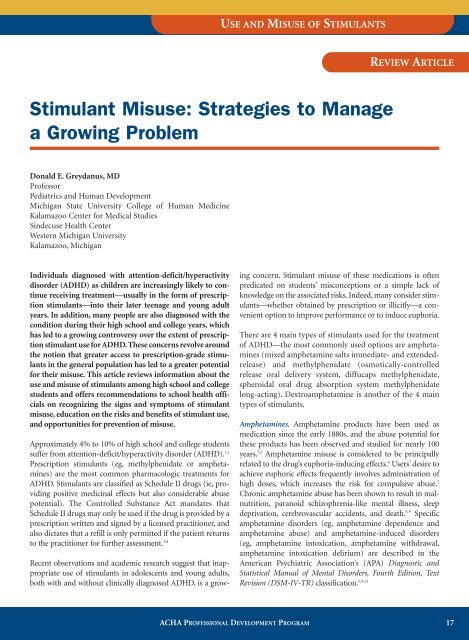
![Final Program [5.4MB pdf] - American College Health Association](https://img.yumpu.com/49022356/1/190x245/final-program-54mb-pdf-american-college-health-association.jpg?quality=85)


